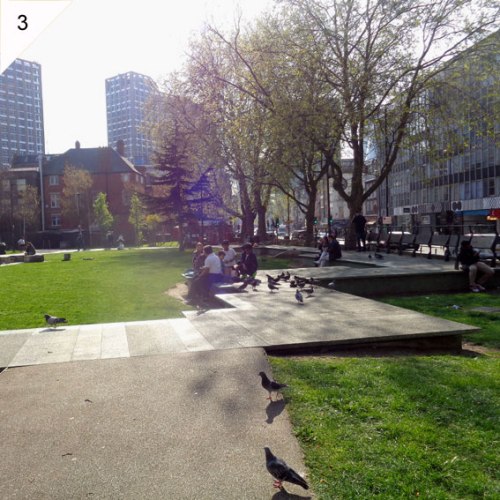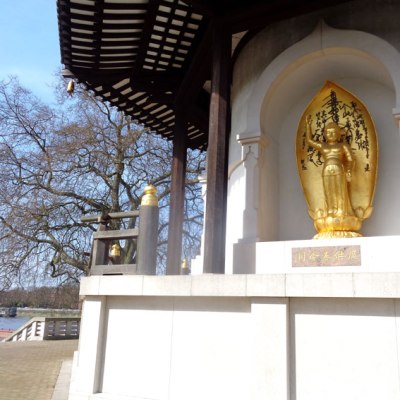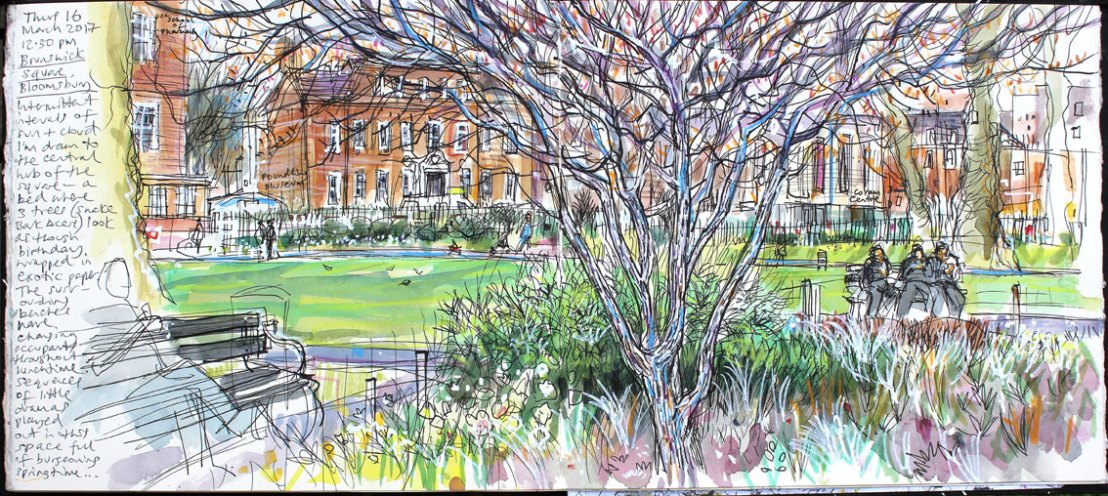“The shade of my tree is offered to those who come and go fleetingly” (Thursday 6 April 2017)
It’s already warm as I step out from East Aldgate tube station and make my way across Whitechapel High Street towards the entrance to Altab Ali Park, not noticing the cycle lane before almost getting mown down by a cyclist who glares at me as I jump back.
Since about 60AD, when the Romans built a road to link London with Colchester (the original Roman capital of Britain), this thoroughfare has been traversed by a whole host of humanity over the millennia, from units of legionaries, peasants with oxcarts, livestock herders, merchants and messengers to today’s van drivers, office workers, cycle couriers, ambulance paramedics and bus passengers. I’m at the point where Whitechapel High Street becomes Whitechapel Road and the busy northeast bound A11 trunk road.
By the 13th century, wayside taverns and inns became established along this road to serve and accommodate travellers to and from the City. A jumbling village of wood and thatch dwellings grew. A church was built, a chapel of ease called St Mary Matfelon (‘Matte Felon’ was the medieval name for knapweed, a common treatment for sores and wounds; it’s possible that the chapel also served as a place for healing injured travellers). Constructed from chalk rubble brought from Kent, sunlight would bounce from its rough surface making it shimmer brightly like a beacon above the surrounding hovels, hence the village name ‘White Chapel‘.
Being a good half mile outside the city walls, Whitechapel attracted many of the less sociable crafts and industries that were nevertheless essential to City life, such as slaughterhouses, horse skinning, horn working, brewing, tanning and foundries (the Whitechapel Bell Foundry, a few steps up the road from here, was established in 1570. It cast Westminster’s Big Ben and Philadelphia’s Liberty Bell, but sadly has founded its final bell and is closing their doors this May). Just to the north, Brick Lane (and its popular Sunday market), is where brick and tile manufacturing took place from the 15th century, using local brick earth deposits.
A diverse mix of trees line the park’s perimeter: planes, birches, Scots pines. A line of twisty trunked robinias, newly decorated with delicate yellowgreen leaflets, the sun making them fluoresce against the neutrals of background buildings. A pair of starlings chase each other, sweeping twice around the park around and through the tree canopies, chirrking crossly before landing on a 6th floor balcony in the apartment block which looms over the southern edge. Above them the cloudless sky is a summery blue.
In the late 1600s the crumbling church was rebuilt in NeoClassical style. But by the mid 19th century this was considered pagan and ugly so was replaced with a fine Gothic revivalist church (photo 2). It had an exterior pulpit for al fresco summer preaching and was famous for its clock which projected out over the street (replicated by a modern clock, fixed to a lamppost, ticking in roughly the same position as the original). The churchyard was no longer used for burials and was planted with trees and shrubs. Today the only reminders that this was once a burial ground are a few eroded gravestones standing in sad rows at the edges of the park, and a prominent chest tomb built in the early 1800s for the Maddock family who were local timber merchants.
I set up near the central path to draw towards the northwest entrance, the ‘Maddock’ tomb in the foreground and the glassy blues of the Gherkin and city skyscrapers behind, glimmering through the warm air. A busy flow of people to and fro along the path. (see drawing at top).
Lunchtime fills the park. Bodies sit in sun or shade. The day heats up, I begin to regret choosing such an exposed spot. A family picnicking nearby seem to be celebrating a young daughter’s birthday. A sudden sparkle catches the corner of my eye- an eruption of bubbles blown by dad soar into the air and fly past me and up over the lawn.
St Mary’s church was firebombed in the 2nd World War and left in ruins. After the war it doubled as a precarious playground for local children and a nocturnal hangout for the homeless. After local complaints the ruins were cleared (sections of the churchyard walls alongside Marylebone Road and the entrance gate stonework still remain) and London County Council landscaped the grounds which were opened as St Mary’s Gardens in 1966.
With every century, the population of Whitechapel has increased in diversity. Like a tapestry on a loom, with successive wefts of immigration adding to its sumptuous and richly detailed substance. In the 17th century Huguenot refugees from France set up their weaving workshops, the origins of this area’s most prominent and longest lasting industry: textiles and clothing. Workers were attracted from across the world by the availability of jobs: Irish, European Jews and, from the mid 20th century, immigrants from Bangladesh (formally East Bengal) all wove their distinctive cultures into the fabric of Whitechapel’s community.
As immigration grew, so did far right extremism in the east end of London. With marches and banners and slogans, the National Front were fuelling resentment on these streets. Incidents of racial violence were increasing. On the evening of 4 May 1978, Altab Ali (a 25 year old mechanic, who’d recently arrived in London from Bangladesh) was walking to his bus stop after work at a textiles factory in Brick Lane, when he was chased and attacked by three teenagers who stabbed him to death in Adler Street, just to my right. This horrific murder was a huge shock. On the day of Ali’s funeral, thousands took part in a demonstration against racial violence, marching from here to Whitehall. The local Bengali population were mobilised and, through their campaigning, were able to rid Whitechapel of the National Front and, in doing so, became more cohesive as a community. In 1989, St Mary’s Gardens was renamed Altab Ali Park to honour Ali and all victims of racial violence. In 2010 the Altab Ali Foundation was founded which, every 4th May holds Altab Ali Day to commemorate all victims of racism.
Rising from just behind the original churchyard gateway is a sculptural arch (photo 4) created by Welsh blacksmith sculptor David Petersen. It was commissioned in 1989 as a memorial to Altab Ali and other victims of racism. The design combines elements from Bengali and western Gothic architecture, but is woven together with playfully draped ironwork ribbons, symbolising the coming together of these two cultures in East London. At its opening, children processed under the arch wearing headdresses inspired by the arch and carrying red carnations (it is a Bengali tradition to pass under an arch at important events such as at weddings and funerals). An extract from a poem by Bengali poet, Rabindranath Tagore, was carved along the park’s central park, reading “The shade of my tree is offered to those who come and go fleetingly” (could be a slogan for all public green spaces). Sadly this text was subsequently tarmacked over during relandscaping in 2011.
The southern section of the park is undulating hummocks adorned with sculptural tree stumps and large boulders and planted with stands of birches and pines. Also a viewing platform across to the Shaheed Minar monument (photo 5), a smaller replica of the one in Dhaka, Bangladesh, representing a mother and her martyred sons. Erected in 1999, it commemorates students from Dhaka University and activists of the Bengali Language Movement who were shot and killed by Pakistani police during a demonstration in 1952 demanding official status for their native tongue. Today, geometric shadows rake across its platform and over a heaped collection of dried flowers and wreaths and banners in Bengali script: decaying remnants from Martyr’s day on 21 February: the anniversary of the massacre (activities which take place on this day include traditional Bengali Alpana painting on the paved areas of the park, using starch paste paint to create motifs and patterns).
The front section of the park, bordering Whitechapel Road, is as flat as a floor, where once the churches stood (see photo 2). In 2011, this was landscaped by students from the nearby Sir John Cass School of Art, Architecture and Design. Stone architectural blocks were carved based on pieces uncovered in an archaeological dig. These are embedded in the lawn, along with fragments of tiled flooring, a surreal hint at the ghost of the 17th century church (photo 6). A congregation of lunchers are sitting on or amongst this stonework, relaxing and chatting and letting today’s sermon of sunshine wash over them. Zigzagging through is a raised terrace (photo 3) which follows the outline of the Victorian church and also acts as seating, picnic table, impromptu bar, children’s play wall and performance stage.
In need of shade I close my sketchbook and walk across to sit on the edge of the raised walkway. Further along, a man with curly white hair (in ageing rock star fashion), leather jacket and croc shoes is strumming a guitar. At my feet the ground is scuffed soil imprinted with shoe sole patterns. There’s a litter of beer bottle tops, cig ends, plane tree twigs and a scatter of dropped smarties. Just next to me a man lifts his daughter down from his shoulders to sit on the edge and she drops her fluffy toy lamb face first into the earth. The little girl cries and, for a second or two, before dad snatches it up, the lamb has a bent cigarette stuck to its stitched mouth.
I look up. Shadows across the blank walls of Adler Street seem like painted Alpana patterns. Over the roofs and treetops the moon hangs like a hazy bubble, hanging flimsy in the sapphire sky. A Virgin jet climbing steeply cuts across it.
(The Altab Ali Story by Julie Begum is being performed by Richmix on 4th May 2018. Go to https://www.richmix.org.uk/events/theatre/altab-ali-story for details.)
In his ‘Sticks in the Smoke’ project, Nick Andrew has been regularly visiting, researching and drawing different publicly accessible parks or gardens in London since January 2016, exploring the theme of city green spaces from the perspective of a rural landscape painter. The first two sketchbooks will be published as a book in late 2018. www.nickandrew.co.uk . Nick is grateful to London Parks & Gardens Trust for their support www.londongardenstrust.org.
Altab Ali Park, Whitechapel Road, London E1 7QR
Unrestricted opening
Google earth view here
Line drawings of churches reproduced from London Borough of Tower Hamlets Information panel (photo 2).
























